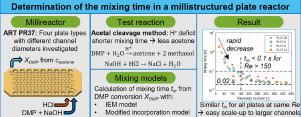Chemical Engineering and Processing: Process Intensification ( IF 3.8 ) Pub Date : 2022-09-08 , DOI: 10.1016/j.cep.2022.109134 Alexander Rave , Lucas Schaare , Georg Fieg

|
The mixing time can strongly affect the yield of a desired product if side reactions occur. Mixing is therefore of great practical importance. Millireactors enable comparatively high flow rates at moderate pressure drops and are thus well suited for production purposes. In this work, the mixing performance of the millistructured reactor ART PR37 is investigated using the Bourne method. Four plate types with similar meandering, converging/diverging process channels, but different hydraulic diameters have been studied over a wide range of Reynolds numbers. Mixing times have been calculated using two different mixing models, the IEM model and a recently introduced modified incorporation model. Mixing times were found to be less than 0.1 second for Reynolds numbers exceeding 150. For higher Reynolds numbers, mixing times in the range of 0.02 to 0.03 s are achievable without prohibitively high pressure drops. The ART PR37 is therefore a promising option for mixing-sensitive reactions.
中文翻译:

ART 板式反应器 PR37 中使用缩醛裂解法和不同混合模型的微混合研究
如果发生副反应,混合时间会强烈影响所需产品的产率。因此,混合具有重要的实际意义。微反应器能够在中等压降下实现相对较高的流速,因此非常适合生产目的。在这项工作中,使用 Bourne 方法研究了微型结构反应器 ART PR37 的混合性能。四种板类型具有相似的曲折、会聚/发散的工艺通道,但不同的水力直径已在广泛的雷诺数范围内进行了研究。使用两种不同的混合模型计算混合时间,即 IEM 模型和最近引入的修改合并模型. 对于超过 150 的雷诺数,发现混合时间小于 0.1 秒。对于更高的雷诺数,可以实现 0.02 到 0.03 秒范围内的混合时间,而不会产生过高的压降。因此,ART PR37 是混合敏感反应的有前途的选择。











































 京公网安备 11010802027423号
京公网安备 11010802027423号